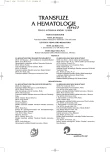Hemorrhagic complications during warfarin therapy
Krvácivé komplikace při léčbě warfarinem
Krvácení je pravděpodobně nejvýznamnější komplikací antikoagulační léčby antagonisty vitaminu K, dnes u nás především warfarinu. Mezi hlavní rizikové faktory hemoragických komplikací warfarinizace patří intenzita a nestabilita antikoagulační léčby, individuální vlastnosti pacienta, interakce warfarinu s jinými léky a délka antikoagulační terapie. Vážné krvácení u pacientů na warfarinu je nejúčinněji zajištěno rychlým a kompletním zrušením antikoagulačního efektu léku pomocí koncentrátu protrombinového komplexu a pomalé i.v. infuze vitaminu K1 nezávisle na důvodu pro antikoagulaci. Tento přístup může zajistit minimalizaci následků krvácení. Méně vážné krvácení nebo asymptomatické vystupňování mezinárodního normalizovaného poměru může být účinně léčeno vynecháním nebo snížením dávky warfarinu a/nebo perorálním podáním vitaminu K1 (i.v. podáním jen ve vybraných rizikových případech), které sice vede jen k částečné úpravě koagulopatie, nicméně takové, kterou vyžaduje stupeň rizika rekurence trombotické příhody. Text si klade za cíl přispět ke standardizaci péče o pacienty s předávkováním warfarinu a/nebo s hemoragickými komplikacemi léčby warfarinem a je k dispozici na www.thrombosis.cz. Součástí doporučení je příruční leporelo, které má sloužit pro bezprostřední, velmi rychlou orientaci v klinické praxi.
Klíčová slova:
warfarin, krvácení, vitamin K, koncentrát protrombinového komplexu, plazma, rekombinantní aktivovaný FVII
Authors:
J. Gumulec 1; P. Kessler 2; M. Penka 3; D. Klodová 1; S. Králová 1; M. Brejcha 1; W. Wróbel 1; E. Šumná 1; J. Blatný 3; K. Klaricová 1; P. Riedlová 1; Z. Lasota
Authors‘ workplace:
Onkologické centrum J. G. Mendela Nový Jičín
1; Oddělení hematologie a transfuziologie Nemocnice v Pelhřimově
2; Oddělení klinické hematologie Fakultní nemocnice Brno
3
Published in:
Transfuze Hematol. dnes,12, 2006, No. 2, p. 83-84.
Category:
Comprehensive Reports, Original Papers, Case Reports
Overview
Hemorrhage is probably the major complication of anticoagulant treatment with vitamin K antagonists represented particularly by warfarin in our country. The main risk factors of hemorrhagic complications of “warfarinisation” are intensity and instability of the anticoagulant therapy, individual patient characteristics, drug interactions, and duration of the anticoagulant therapy. Severe hemorrhage in patients treated with warfarin is most effectively prevented by fast and complete suppression of anticoagulant effect of the drug using a prothrombin complex concentrate and slow intravenous vitamin K1 infusion regardless of the reason for anticoagulation. This approach can minimize frequencies of hemorrhage consequences. Less severe or asymptomatic hemorrhage with an increased international normalized ratio can be effectively treated by withdrawal or reduction of warfarin dosage and/or peroral administration of vitamin K1 (intravenous administration only in selected high-risk cases). The latter results only in a partial correction of coagulopathy, nevertheless to a such extend that is required with respect to the risk of recurrence of thrombotic event. The objective of this article is to contribute to the standardization of the treatment for patients overdosed with warfarin and/or for patients with hemorrhagic complications due to warfarin therapy. It is available at www.trombosis.cz. The guidelines include a handbook that is used for immediate, and very quick orientation in the clinical praxis.
Key words:
warfarin, hemorrhage, vitamin K, prothrombin complex concentrate, plasma, recombinant activated factor VII.
Labels
Haematology Internal medicine Clinical oncologyArticle was published in
Transfusion and Haematology Today

2006 Issue 2
- Vascular Disease in the Gradually Aging Population of Hemophiliacs: An Underestimated Problem?
- Cost Effectiveness of FVIII Substitution Versus Non-Factor Therapy for Hemophilia A
- Prognostic Significance of Subclinical Joint Changes on MRI in Hemophilia
- Immunotolerance is still the goal of management of hemophilia A with inhibitor in the era of non-factor therapy
- Minimum and Optimal Factor Levels in Physically Active Hemophiliacs
Most read in this issue
- Chronic idiopathic myelofibrosis: biological characterization and histological “grading” of the fibrosis with respect to diagnosis and prognosis
- Anagrelide in the treatment of thrombocytosis in myeloproliferative disease – case report
- Hemorrhagic complications during warfarin therapy
- Idiopathic thrombocytopenic purpura in pregnancy refractory to immunosuppressive treatment – case report
